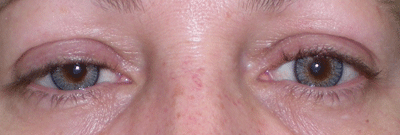 Q: I have a rigid contact lens wearer who has experienced a significant ptosis on the left side—could this be a disinsertion of the levator aponeurosis? What is the patient’s necessary hiatus from lens wear following surgical repair?
Q: I have a rigid contact lens wearer who has experienced a significant ptosis on the left side—could this be a disinsertion of the levator aponeurosis? What is the patient’s necessary hiatus from lens wear following surgical repair?
A: “Rigid lens-induced eyelid ptosis is a well-established condition,” says John Lee, MD, an ophthalmologist and oculoplastic surgeon practicing in Southeastern Pennsylvania and Maryland. “It is thought to be caused by years of mechanical traction from pulling the lids while removing the lens.”
The diagnosis of lens-induced levator disinsertion (aponeurotic ptosis) is made clinically. “An increased lid crease height with normal levator function is indicative of levator dehiscence,” Dr. Lee says. Another possible cause of eyelid ptosis may be irritation and/or inflammation of the conjunctiva due to the lens itself.
So, inspect the conjunctiva for signs of papillary conjunctivitis associated with contact lens use, in addition to checking the patient’s pupils for abnormalities to rule out Horner’s (especially a smaller pupil on the side with ptosis).
Surgical options for aponeurotic ptosis include:


A patient with right upper lid ptosis, before and after surgical correction.
- An external levator resection, which involves making an external incision along the eyelid crease. “These patients typically use antibiotic ointment for several weeks (post-op),” Dr. Lee says. “The combination of antibiotic ointment and postoperative swelling makes it difficult for patients to wear contact lenses immediately after surgery.” They typically resume wear two to six weeks after surgery.
- A Fasanella-Servat/Müllerectomy procedure, which is performed on the conjunctiva. “These patients often use a soft bandage contact lens for one week after surgery and can return to their normal contact lenses during the second week,” Dr. Lee says. Antibiotic drops are used for two weeks after surgery.
“I tell patients to wait a minimum of three weeks before resuming lens wear, but it may take as long as six weeks for complete adherence of the levator muscle to the tarsal plate in its new position,” says Robert Penne, MD, director of the Oculoplastic and Orbital Surgery Service at the Wills Eye Institute in Philadelphia. “I usually also have them see their CL professional to get a plunger to remove their rigid lenses for another three weeks so they’re not pulling on their eyelid.” Continued use of the plunger may be prudent to minimize the pulling effect on the lid with forceful removal. Some patients may be best suited for a soft lens re-fit.
An update in the contact lens parameters may be necessary after surgery due to the change in eyelid and lens dynamic. “Warn patients that their lenses may sit differently,” Dr. Penne says. “They may have more problems wearing their lenses, even if the lens is in exactly the same position (as it was before surgery), patients may feel drier and have more trouble wearing their lenses.”

